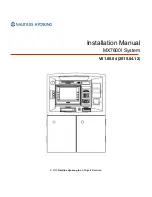
28
8. TROUBLESHOOTING GUIDE
8.1
Vibratory Feeder
A broken leaf spring causes either slow or uncontrollable feeding If no loose bolts, broken springs
or isolation mounts are found, the cause may be electrical.
8.2
Diverter Assembly
If chutes are sharply bumped or used as handles to move the Count-A-Pak, the diverter
assembly may be damaged. Electrical failures are often broken or loose solenoid cable
connections. Correct any malfunctions immediately. The majority of diverter chute problems are
mechanical binding.
To test the operation of the diverter chute assembly, run a BATCH REPEAT test. Set terminal
count to a small number (i.e., 3). Interrupt light beam with finger, pencil, or similar object. A
solenoid is energized to change delivery chutes at the end of each batch.
If diverter flap is stuck, turn off the OCC. Locate the indicator knob (on front of chute assembly)
and turn with fingers. Flap should turn freely in either direction until contact is made with diverter
housing. Even the slightest binding may cause sticking. A slight squeak is OK.
8.2.1 Electrical Problems
It is an electrical problem when one or both solenoids fail to energize. Solenoids are energized
alternately as batch totals are reached. Do a BATCH REPEAT test. A de-energized solenoid
offers no resistance to turning. If one solenoid fails to energize, the problem is either the solenoid,
the cable, or the drive circuitry in the OCC. If an ohmmeter is available, the solenoid circuits in the
SHB can be checked for open circuits. A reading of 30 to 45 ohms should be obtained between
pins 4 and 5 of the larger connector on the rear of the SHB for the right solenoid. The left
solenoid should read the same between pins 7 and 8. The solenoid connections can be switched
between the right-hand and left-hand solenoid to help isolate the problem also.
8.2.2 Mechanical Problems
The diverter flap actuator is located on back of the diverter chute assembly (see Figure 8-1). It is
necessary to remove entire diverter chute assembly from cabinet to check or adjust actuator.
To adjust actuator, loosen three 11/32" (8.8 mm) nuts on back of assembly. Do not remove.
Adjust angle bracket to position actuator so that solenoid plungers and diverter flap are centered
as shown. Tighten all three screws and test flap movement. Position diverter assembly for
proper gap to feeder bowl discharge area when assembling to cabinet.











































